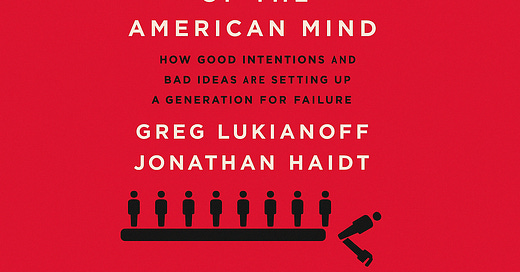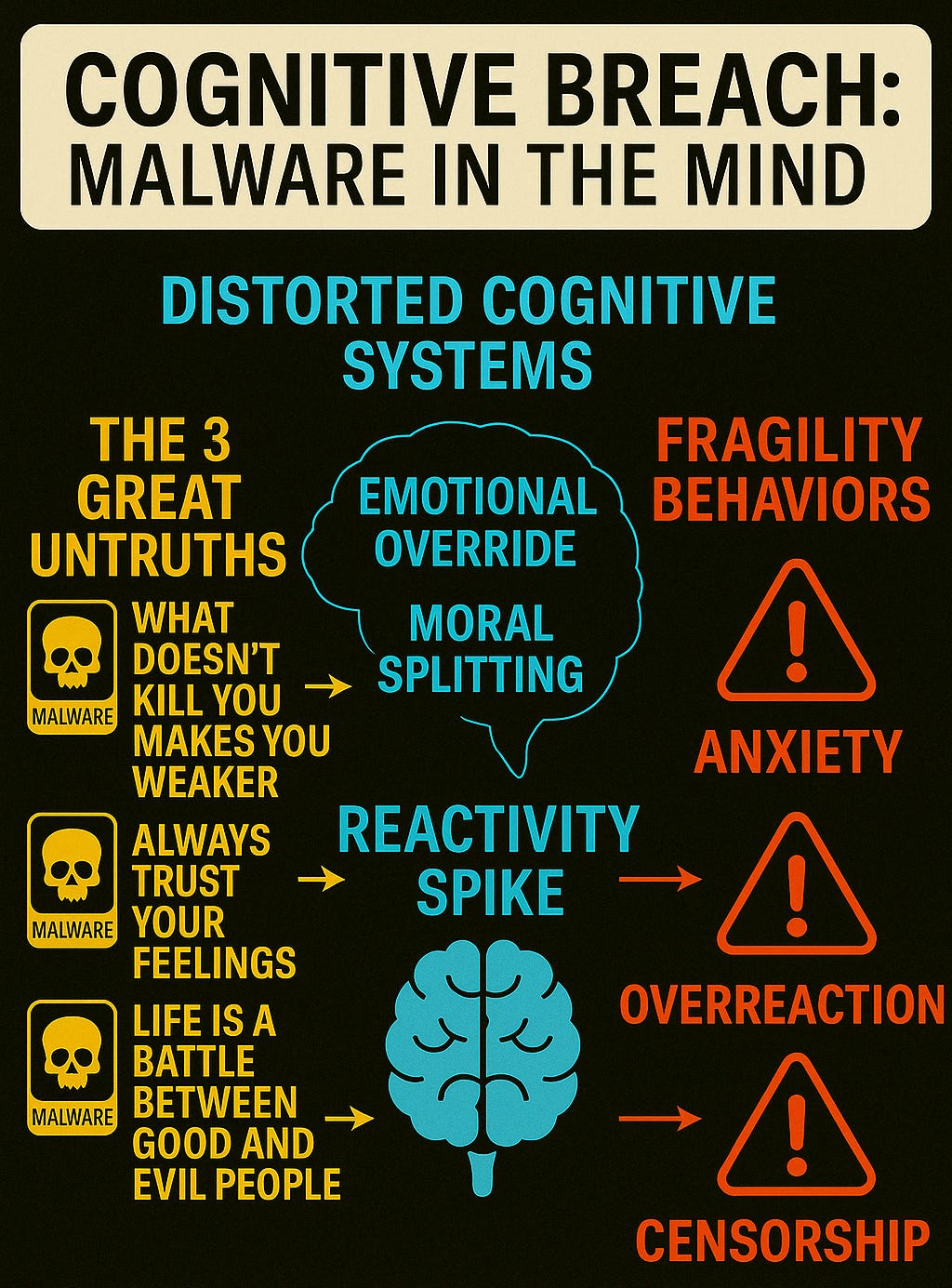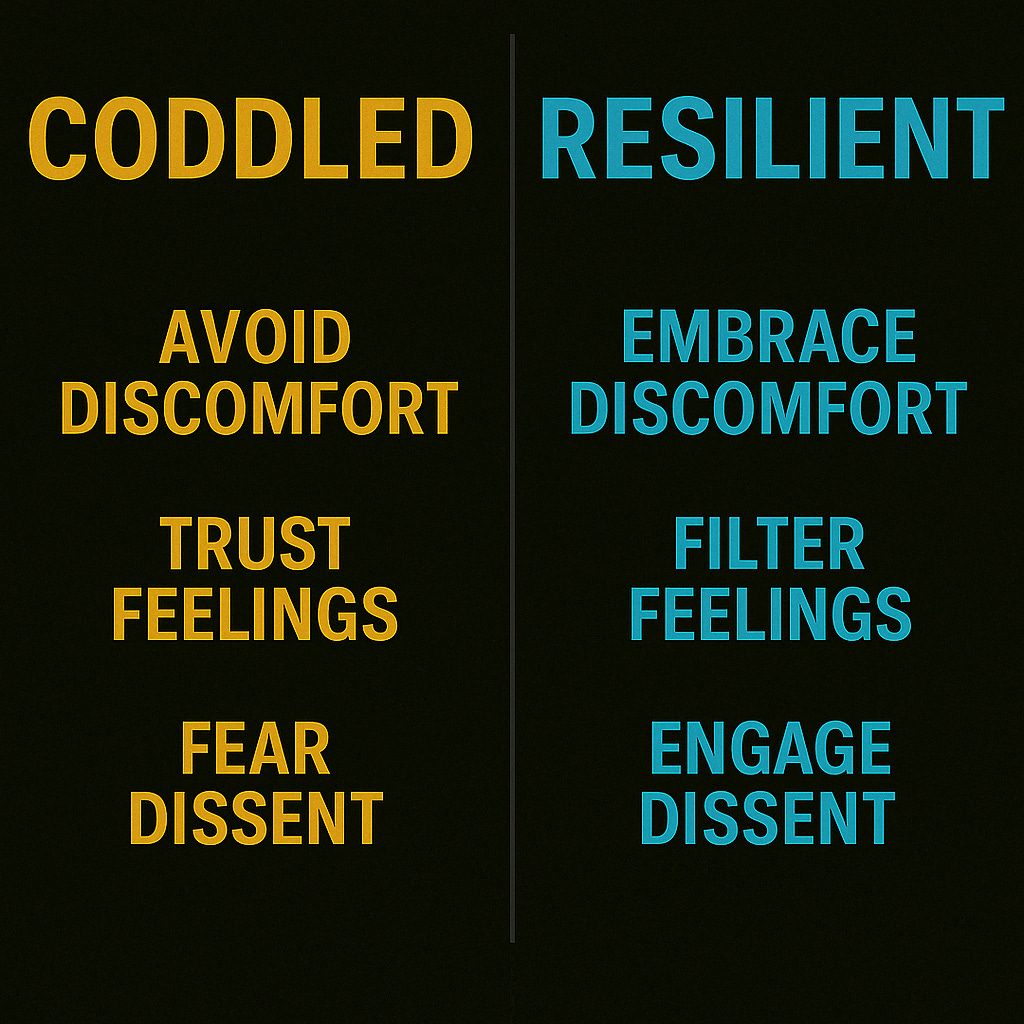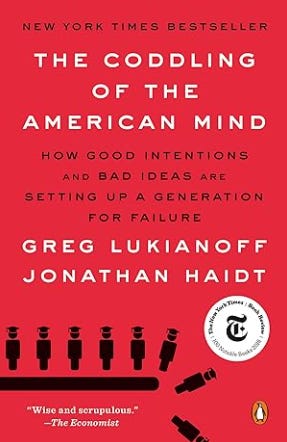Book Review: The Coddling of the American Mind by Greg Lukianoff and Jonathan Haidt
The Psychological Malware Undermining Truth, Resilience, and Dialogue
Situation Report
Transmission Context: Code Red — Cognitive Resilience Systems Failing
The world isn’t necessarily more dangerous—it just feels that way.
Back in 2018, when The Coddling of the American Mind hit shelves, the cultural atmosphere was already thick with campus protests, ideological clashes, and rising rates of anxiety and depression among teens. The post-Parkland movement was surging. #MeToo was transforming social norms. Online outrage cycles were spinning faster. And still, the full extent of the youth mental health crisis hadn’t yet been grasped.
In that moment, social psychologist Jonathan Haidt and civil liberties attorney Greg Lukianoff issued this field manual for mental resilience—a call to rethink how we raise, educate, and challenge young people. Their central warning? That we were teaching the next generation fragility in the name of compassion.
What started as a well-meaning effort to protect kids—emotionally, physically, ideologically—had morphed into a cultural operating system based on avoidance, hypersensitivity, and institutionalized emotional reasoning. Trigger warnings. Safe spaces. Speech codes. The price of shielding minds from discomfort was becoming clear: weaker resilience, fuzzy thinking, and the erosion of civil discourse.
This is a book about ideas—and specifically, bad ones. Haidt and Lukianoff isolate three "Great Untruths" that violate ancient wisdom, modern psychology, and plain common sense. These mental bugs took root in schools, homes, and media—and the result was a generation less equipped to handle challenge, nuance, or conflict.
“Our culture has been unintentionally teaching young people the opposite of ancient wisdom and modern psychological findings.”
This isn’t about nostalgia or toughness for toughness’ sake. It’s about understanding the cognitive terrain we’ve created—and training minds to thrive in it.
Update from the Field
In 2024, Jonathan Haidt followed up with The Anxious Generation, doubling down on his earlier thesis and shifting the lens to smartphones and social media. Where Coddling examined education and ideas, Anxious Generation focused on digital environments, childhood structure, and mental health data that has only worsened since 2018.
Together, the two books form a tactical blueprint: Coddling identifies the malware. Anxious Generation traces the vectors of transmission.
We'll explore The Anxious Generation in a future Protocol One review—but the urgency Haidt and Lukianoff warned about here? It's only grown louder.
The Three Great Untruths
Classified Contaminants in Cognitive Resilience
Haidt and Lukianoff trace the mental unspooling of modern culture to three bad ideas—ideas that seem compassionate on the surface, but corrode our ability to think, feel, and relate with strength.
Each of these “Great Untruths” is both psychologically false and culturally destructive. They’re not just incorrect—they’re anti-knowledge, reversing centuries of wisdom from philosophy, religion, and neuroscience alike.
☣️ 1. What Doesn’t Kill You Makes You Weaker
The fragility fallacy.
This idea turns antifragility on its head. It suggests that discomfort, difficulty, or emotional challenge should be avoided at all costs. But modern psychology—and ancient wisdom—says otherwise.
In truth:
Stress, strain, and challenge build capacity—in muscles, minds, and societies. Just as vaccines work by exposing the immune system to manageable threats, emotional resilience is trained through safe but real adversity. Shielding young people from all harm removes their ability to adapt.
“Children are antifragile—not fragile. They require challenges and stressors to grow strong.”
The real threat?
A generation trained to avoid discomfort becomes unequipped to handle the basic frictions of life—criticism, rejection, uncertainty. The result is rising rates of anxiety, depression, and emotional paralysis.
Growing up Gen X, this principle wasn’t just advice—it was reality. We walked to school alone. We solved problems without Google. We took hits—physically, emotionally, socially—and learned to get back up. That’s what built resilience. The idea that struggle weakens rather than strengthens? That would’ve sounded like parody. Today, it’s policy.
☣️ 2. Always Trust Your Feelings
The authority of emotion over evidence.
This Untruth teaches that feelings are sovereign—that your internal emotional state is the best measure of truth. In this framework, being offended becomes proof that harm has occurred.
In truth:
Feelings are data—not directives. Just because you feel anxious doesn’t mean danger is present. Emotions like fear, anxiety, or sadness can be useful signals, but they are often distorted by cognitive biases, past trauma, or social influence. Elevating them above facts undermines critical thinking.
“Cognitive Behavioral Therapy (CBT) is based on challenging irrational thoughts—not validating them uncritically.”
Ironically, many campus policies that reinforce this Untruth directly contradict CBT—the gold-standard therapy for emotional regulation. By treating discomfort as harm, we amplify distress rather than helping people process and overcome it.
Result:
A culture of emotional reasoning replaces rational dialogue. Feelings become both sword and shield, used to silence dissent and avoid scrutiny.
☣️ 3. Life Is a Battle Between Good People and Evil People
The tribalism trap.
This final Untruth reframes human interaction as a moral warzone. You’re either with us or against us—ally or enemy, oppressed or oppressor. Intent no longer matters. Identity becomes destiny.
In truth:
People are complicated. Motives are mixed. And growth happens in the gray. The belief in irredeemable “others” fosters cognitive distortion, inhibits empathy, and destroys pluralism.
“Seeing the world as a battle between good and evil people encourages confirmation bias, dehumanization, and moral rigidity.”
What’s lost?
Curiosity. Dialogue. The possibility of shared truth. In this framework, debate becomes dangerous, and disagreement becomes betrayal.
CORTEX OPs: The Brain Science Behind Cognitive and Emotional Malware
Neurocognitive Systems Analysis: Resilience Protocol Failure
Antifragility & Neural Growth
System Affected: Prefrontal Cortex + Stress Adaptation Pathways
The brain is a use-dependent organ. Like muscle, it strengthens through resistance. Mild-to-moderate stress, properly framed, enhances cognitive flexibility and emotional regulation.
But when environments eliminate all friction?
The brain is deprived of developmental stressors—the very inputs it needs to calibrate fear response, impulse control, and long-term planning.
No challenge = no adaptation.
In immunology, this is the hygiene hypothesis. In psychology, it’s learned helplessness.
Neural pruning accelerates in adolescence. If discomfort is consistently avoided, the result isn’t safety—it’s stunted circuitry.
Emotional Reasoning & Amygdala Hijack
System Affected: Amygdala, Insula, Ventromedial PFC
Untruth #2 (“Trust your feelings”) disables cognitive override.
Normally, the prefrontal cortex evaluates emotional signals from the amygdala, filtering irrational or exaggerated reactions. But in cultures that validate all emotion as truth, the filter is bypassed.
This leads to:
Heightened threat perception
Reinforcement of anxious thought loops
Inability to tolerate ambiguity or disagreement
“You feel unsafe” ≠ “You are unsafe”
But if every internal signal is treated as a crisis, the brain learns to fire the alarms more often, not less.
Tribalism, Cognitive Distortion, & Moral Splitting
System Affected: Default Mode Network, DLPFC, Mirror Neuron System
Humans are hardwired for group identity and moral alignment. But this wiring is vulnerable to distortion:
Moral splitting (us = good, them = evil) reduces complex thought to binary categories
Group conformity pressure suppresses dissent, even silently held doubts
Mirror neurons and online echo chambers amplify emotional contagion, especially outrage
These systems are useful in moderation—but dangerous when turned up to 11. The brain starts categorizing disagreement as betrayal, and nuance as weakness.
Identity-based reasoning hacks the brain’s empathy circuits and turns tribal allegiance into a moral obligation.
Why CBT Matters More Than Ever
Cognitive Behavioral Therapy is the antidote to all three Untruths.
It teaches you not to trust every thought or feeling
It reframes discomfort as manageable and meaningful
It restores agency over how we interpret experience
But CBT requires practice. It requires challenge. It requires mental reps under cognitive load. In coddled environments, none of this training occurs.
The result? A generation that is unvaccinated against emotional distortion.
Tactical Takeaways
Resilience Engineering for the Next Generation of Minds
Haidt and Lukianoff don’t just diagnose the problem—they prescribe actionable responses. These takeaways are your field manual for resisting fragility and rewiring strength into your environment, relationships, and internal dialogue.
1. Reject Safetyism
Stop equating discomfort with danger. Recognize that resilience can only be built through controlled exposure—not avoidance.
Let your children struggle. Guide them, but don’t bubble-wrap them.
In leadership? Set high expectations. Praise progress through adversity.
In community? Advocate for courage culture, not cancel culture.
“Prepare the child for the road, not the road for the child.”
2. Challenge Emotional Reasoning
Feelings matter—but they don’t define truth. Practice—and teach—cognitive override.
Use CBT-style questioning:
→ “What evidence do I have for this feeling?”
→ “Is this an accurate or exaggerated interpretation?”Recognize when “I feel unsafe” is a psychological echo, not a physical reality.
De-escalate emotion with logic. Self-coaching is a tactical skill.
Your brain isn’t a courtroom for your emotions. It’s a command center. Operate accordingly.
3. Train for Civil Disagreement
Disagreement isn’t danger. It’s opportunity. A culture that fears debate breeds ignorance and brittle minds.
Steelman opposing views before you refute them. Seek understanding over victory.
Separate ideas from identity. Critique the claim, not the person.
Reward intellectual humility. Make curiosity a virtue, not a vulnerability.
Progress comes not from agreement—but from dialogue.
4. Raise Antifragile Humans
Whether parenting, mentoring, or leading: build humans who adapt under pressure.
Tell stories of failure, recovery, and grit—not just success.
Let the young wrestle with challenge before offering answers.
Don’t pathologize ordinary stress. Normalize it. Reframe it.
The goal isn’t to avoid pain. The goal is to build through it.
5. Fortify Institutional Integrity
If you’re part of an educational or organizational system:
Push back against policies that reward hypersensitivity and suppress debate.
Support training in critical thinking and media literacy over DEI dogma or viewpoint censorship.
Champion open inquiry—even when it makes people uncomfortable.
You can’t educate without friction. You can’t grow without resistance.
🧠 Mental OS Check: Malware Detected… or System Hardened?
📒 For Those Who Won’t Read It
Field Brief: Core Mission Summary
The Coddling of the American Mind isn’t a partisan screed. It’s a psychological operations manual—written to decode how well-meaning ideas are backfiring across education, parenting, and society.
Haidt and Lukianoff argue that we’ve embraced three cultural lies:
What doesn’t kill you makes you weaker
Always trust your feelings
Life is a battle between good people and evil people
These untruths sound empathetic. But they train the mind to avoid challenge, elevate emotion above reason, and reject nuance in favor of tribal moral purity. The fallout? Record levels of anxiety, ideological polarization, and a population increasingly unfit for real-world complexity.
The fix isn’t cruelty.
It’s challenge.
It’s truth-seeking.
It’s reality-based resilience.
This book offers a counter-script: teach cognitive toughness, embrace discomfort, and restore the capacity for civil disagreement.
If you want to raise strong minds, stop coddling them.
⚖️ Critique Node
Deconstructing the Framework — Strengths and Shortcomings
The Coddling of the American Mind has sparked wide discussion across ideological lines. It’s been praised for its clarity and cultural relevance, but also critiqued for its blind spots. Here’s a balanced breakdown:
✅ What It Gets Right
Psychological Insight Made Accessible
The book succeeds in translating behavioral science into plain language. By introducing concepts like cognitive distortions, emotional reasoning, and antifragility, it arms readers with real tools—not just opinions.Cross-Disciplinary Fusion
Haidt (a psychologist) and Lukianoff (a legal scholar) blend fields with clarity. Their argument is grounded in both empirical research and first-hand legal experience on college campuses.Cultural Timing
In 2018, this book was ahead of the curve. It saw the rise of safetyism, emotional fragility, and political polarization before those patterns were widely acknowledged.Tactical Prescriptions
The authors don’t just diagnose—they offer strategies. Their promotion of CBT, open inquiry, and resilience-building gave many parents, teachers, and students a much-needed framework.
⚠️ Where It’s Vulnerable
Focus Skewed Toward Universities
The book's early warnings focused on college campuses, where the authors had direct case experience. But today’s crisis is far deeper and younger—driven by smartphones and social media. Haidt has since addressed this head-on in The Anxious Generation, a clear follow-up that expands and updates the tactical picture.CBT as a Cure-All
CBT is a powerful tool and one of the most scalable interventions available. But the book leans hard on it as a fix-all. Some cases—especially those involving trauma or systemic dysfunction—need more than mental reframing. That said, CBT remains a battle-tested baseline worth teaching widely.Lack of Spiritual or Moral Grounding
The book frames the problem as psychological and cultural—but sidesteps the spiritual. Without a transcendent moral anchor, young people often root their identity in ideology, grievance, or victimhood. This spiritual vacuum may be the true driver of fragility. A generation unmoored from deeper meaning will look for it in all the wrong places.Tone Drift Toward Condescension
At moments—especially when critiquing Gen Z—the tone risks slipping into generational eye-rolling. Fragility is real, but it shouldn’t be pathologized wholesale. The most effective resilience-building is done with empathy, not mockery. And while the data is sound, tone matters when you're trying to reach the very audience that needs this message most.
🎙️ Final Transmission 🎧
Signal Lock: Restoring Cognitive Integrity
The Coddling of the American Mind isn’t just commentary—it’s a diagnostic. A readout of how culture, psychology, and education have drifted off course. Haidt and Lukianoff deliver a clear warning: in trying to protect young people, we’ve made them more fragile.
We’re raising minds untrained for adversity. Nervous systems attuned to threat where there is none. Hearts that confuse discomfort with harm—and disagreement with violence.
The three Great Untruths—emotional supremacy, fragility-as-virtue, and tribal moral binaries—aren’t just wrong. They’re anti-resilience code. And they’re spreading.
But there’s a countermeasure.
It begins with truth-seeking over emotional reasoning. With training antifragile habits. With modeling civil disagreement. With teaching minds to sort signal from noise and strength from softness.
In a world that rewards reactivity, stillness is rebellion.
In a culture of coddling, challenge is a gift.
And in the war for resilient minds—you are the frontline.
Clear thinking is a tactical advantage.
As a member of Generation X, I was raised with the assumption that adversity was part of the deal. We weren’t shielded from discomfort—we were expected to face it, adapt, and move forward. That built antifragility by default. Reading this book reminded me just how far we've drifted from that baseline. Fragility is now institutionalized—and resilience must now be trained.
But psychological toughness isn’t the full answer. It never has been.
Generation X was named because no one knew what we were. We weren’t the Boomers. We weren’t yet the Millennials. We were the middle child of culture—figuring things out without a manual. Society didn’t know what to make of us. But those of us who found our spiritual identity didn’t just survive—we became unbreakable. And those who didn’t? They built safe spaces and learned to call fragility strength.
Resilience isn’t just mental—it’s spiritual. A strong identity rooted in truth gives you something solid to build on. Because a strong operator needs a strong operating system.
We can’t pin this entirely on Boomers, Millennials, or Gen Z. Generation X was supposed to be forged in independence—and we were. But somewhere along the way, we let comfort creep in. We softened.
We became parents, leaders, influencers. And in trying to protect, we overcorrected. We didn’t just pass along our grit—we also passed along our uncertainty.
But it’s not too late.
Now, in our strongest years, we’re raising Generation Alpha. And if we do it right, they could be the most formidable yet—carrying Gen X’s resilience, Millennial creativity, and Gen Z’s digital fluency... with none of our weaknesses.
Let’s not repeat the cycle. Let’s train them to operate from clarity, conviction, and a rock-solid foundation.
That parable about building your house upon the rock? It’s not just truth—it’s neurodesign, straight from the Source.
[FIN/ACK]
Transmission Complete
Process Accordingly
—Protocol One
📦 Want to read the source intel firsthand and Fuel the Next Mission?
The Coddling of the American Mind is worth absorbing in full—especially if you're raising, leading, or educating in today’s psychological landscape.
👉 The Coddling of the American Mind – Amazon Link
As an Amazon Associate, I earn from qualifying purchases—at no extra cost to you. It helps fuel future transmissions, one click at a time.










![Glitch-style digital banner with CRT lettering that reads “CREATOR ONLINE – IDENTITY ROOTKIT: INSTALLED,” followed by “[FIN/ACK] --Protocol One.” A Matrix-inspired command-line visual representing spiritual and cognitive reprogramming. Glitch-style digital banner with CRT lettering that reads “CREATOR ONLINE – IDENTITY ROOTKIT: INSTALLED,” followed by “[FIN/ACK] --Protocol One.” A Matrix-inspired command-line visual representing spiritual and cognitive reprogramming.](https://substackcdn.com/image/fetch/$s_!DXoX!,w_1456,c_limit,f_auto,q_auto:good,fl_progressive:steep/https%3A%2F%2Fsubstack-post-media.s3.amazonaws.com%2Fpublic%2Fimages%2F10c67870-363d-4870-9046-32ef1f06e126_1024x1024.png)
